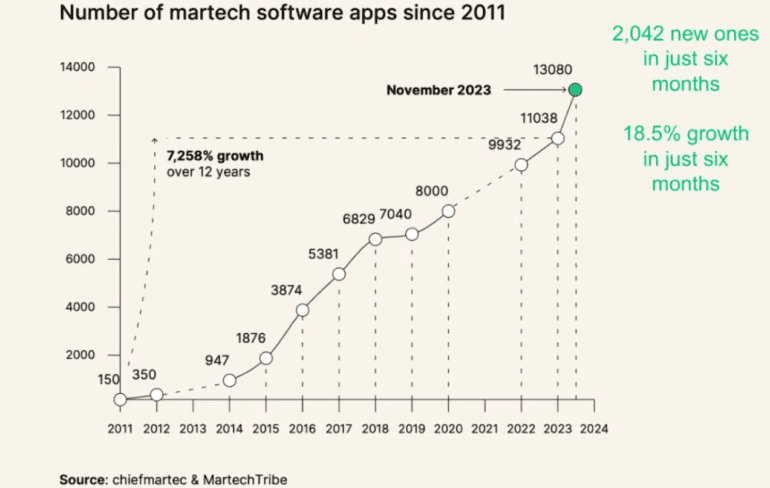TL;DR:
- AI has fueled significant growth in marketing technology solutions, with 2,042 new tools introduced in the last six months.
- 73% of these new tools are powered by artificial intelligence.
- Content tools dominate the AI-based offerings, accounting for 34% of new additions.
- US companies lead the charge in AI martech development, followed by the UK and Iceland.
- Global demand is driving the development of region-specific martech solutions.
- The report emphasizes the importance of balancing discipline and innovation in martech management.
- Despite mergers and acquisitions, the martech industry shows no signs of consolidation.
- Composability and aggregation are emerging trends in martech architecture.
- There is a growing trend towards teams creating their own software, supported by AI.
Main AI News:
In the ever-evolving landscape of marketing technology, the year 2024 has ushered in a remarkable surge in innovation. According to the “Martech 2024” report, authored by industry experts Scott Brinker and Frans Riemersma, a staggering 2,042 new martech tools have emerged in just the past six months. More significantly, a substantial 73% of these tools are driven by the transformative power of artificial intelligence (AI).
The Martech Evolution: A Numbers Game
Since the release of the previous Martech Landscape in May 2023, the marketing technology sector has witnessed an 18.5% expansion, bringing the total number of tools to an impressive 13,080. AI-based solutions, totaling 1,498, have firmly asserted themselves as the driving force behind this growth.
Content Reigns Supreme
While many might assume that content tools would take the lion’s share, the reality is even more profound. Content tools accounted for a substantial 34% of all new AI-based additions, leaving other categories in their wake. Video, the second most prominent category, lagged far behind with only 4.85% representation. Notably, US companies have been at the forefront of this AI revolution, contributing to 61% of these innovative tools. The United Kingdom follows at 5.7%, while Iceland, with its modest population of 373,000, has emerged as an unexpected contender with 4.6% of all AI martech tools launched. Surprisingly, India, with a population of 1.4 billion and a robust tech industry, claims a mere 3.5% share.
Global Demand for Local Solutions
The proliferation of these AI tools globally underscores a growing desire for solutions tailored to their respective regions. These locally developed products resonate with users due to their profound understanding of culture, language and the provision of support in native tongues.
A Deeper Dive: The Report’s Insights
Beyond the headline numbers, Brinker and Riemersma delve into the nuances of the martech industry. They acknowledge that marketing technology is a realm of contradictions, emphasizing the importance of discipline and fiscal responsibility in managing martech while advocating for innovation as a means to gain a competitive edge. The report encourages businesses to dedicate a portion of their time to exploring new tools, even if their immediate use cases are not apparent.
The Expanding Landscape
Despite a flurry of mergers, acquisitions, bankruptcies, and dissolutions, consolidation in the martech space remains elusive. The continuous influx of innovative startups, predominantly cloud-based and subscription-oriented, fuels ongoing growth. The ease of launching martech startups in the cloud, devoid of traditional manufacturing and distribution requirements, contributes to this rapid rate of entry into the market.
The Long Tail Effect
While the report acknowledges a “long tail” distribution among martech companies when measured by revenue and install base, it highlights that long-tail tools occupy approximately half of the solution portfolios, a trend consistent since 2017. These tools find adoption in addressing feature gaps or underperformance in core solutions.
Composability and Aggregation
Two critical trends outlined in the report are composability and aggregation. Composability entails viewing a martech stack as a collection of features and functions rather than a mere assortment of software products. Some vendors now position their offerings as composable, encouraging integration with third-party solutions. Additionally, “horizontal aggregation” is identified as a newer model, emphasizing the aggregation of software around specific layers of the tech stack, such as data, an increasingly vital trend over the past year.
Building from Within
Lastly, the report identifies a nascent trend: teams creating their own software, bolstered by AI support. While these internally developed apps currently revolve around simple workflows and automations, a future where citizen developers shape software to mirror their organizational values and customer-centric goals promises a formidable competitive advantage.
In conclusion, the “Martech 2024” report underscores the transformative role of AI in shaping the marketing technology landscape. As the martech sector continues to expand and evolve, businesses must navigate the delicate balance between discipline and innovation to harness the full potential of these groundbreaking technologies.
Conclusion:
The martech landscape is witnessing a rapid transformation driven by AI, with content tools leading the way. This proliferation of AI-powered solutions presents both opportunities and challenges for businesses. To stay competitive, companies must strike a balance between discipline and innovation, embracing regional and composability trends while keeping an eye on the ever-evolving martech landscape.

